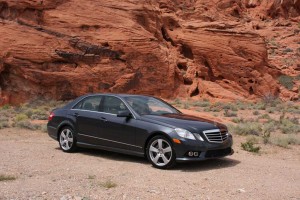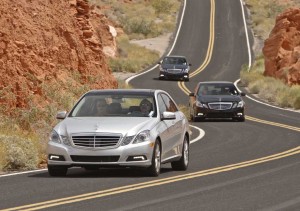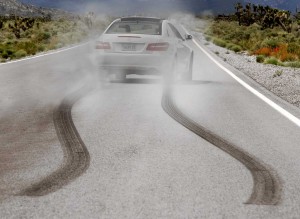
Gambling with success? Actually, Mercedes is holding a winning hand with the completely remade 2010 E-Class sedan.
There’s no such thing as a sure bet, not unless you’re the one holding all the cards. Then again, maybe that describes the Mercedes-Benz E-Class, the sedan that has long dominated the midsize luxury market.
Early this year, the German maker pulled the wraps off an all-new version of the E-Class, and also dropped the surprise news that it was rechristening its 2-door CLK the E-Class Coupe. The new look received strongly favorable reviews, but when it comes to luxury cars, beauty is a lot more than skin deep, so we jumped at the chance to take both the 2- and 4-door versions of Mercedes’ midsize mainstay out for a couple days of testing. We took delivery at the Encore, the newest and, arguably the hottest, resort casino in Las Vegas, a perfect venue considering Mercedes has placed an even bigger bet on its new offering than the highest rollers the strip normally sees.
 The new E-Class is more than just what automotive folks like to call a “simple refresh.” It’s a top-to-bottom remake that, in many ways represents the best Mercedes can muster, even more than the flagship S-Class. And it will take that sort of offering to not only maintain momentum in today’s abysmal automotive market – but also to fend off a growing list of competitors that includes the usual suspects, BMW, Lexus and Audi, as well as the increasingly aggressive Infiniti and the surprising Hyundai Genesis.
The new E-Class is more than just what automotive folks like to call a “simple refresh.” It’s a top-to-bottom remake that, in many ways represents the best Mercedes can muster, even more than the flagship S-Class. And it will take that sort of offering to not only maintain momentum in today’s abysmal automotive market – but also to fend off a growing list of competitors that includes the usual suspects, BMW, Lexus and Audi, as well as the increasingly aggressive Infiniti and the surprising Hyundai Genesis.

Mercedes is offering a wide variety of 2010 E-Class models, including both the E350 and E550, in Sport or Luxury styles, as well as the E63 AMG, the E350 Bluetec and the 4Matic package.
The overall look of the 2010 Mercedes-Benz E-Class sedan is familiar, starting with a slightly widened version of the classic chrome grille. The side view reveals a slightly more upright roofline, the better for rear seat headroom. The rear fenders flare out a little more noticeably, to underscore the power of the new sedan. But the overall look, with its rising beltline designed to give the sedan a feel of constant motion, is instantly recognizable, carrying many of the basic design cues we’ve seen since the legendary 1953 sedan often heralded as the first true E-Class.
Yet, it’s definitely not last year’s model. The most immediate difference can be seen in the headlights. Gone are the four familiar ovoids, replaced by more angular lamps, the outer pair wrapping into the sedan’s fenders. Designers also have added a pair of hockey stick-shaped LED fog lamps in the outer aid intakes.
As it did before, with the smaller C-Class, Mercedes is now offering two distinctly different faces for the midsize E-, the relatively conservative Luxury, and the more dynamic Sport. The latter, which typically dominates the U.S. order bank, features a much more pronounced, blacked out lower air intake and a three, rather than four-bar grille – lamellas, in designer-speak. The Sport also gets twin, squared-off chrome exhaust tips and a blacked-out rear diffuser.
Surprisingly, in an era when most makers keep pushing the dimensions of each new product, Mercedes has stretched the ’10 E-Class only slightly: adding less than an inch to its wheelbase and overall length. Weight is up a bit, but not significantly, and that largely reflects the addition of significant new content, as well as the stiffer body structure. The Sport, incidentally, sits an inch lower than the Luxury.
With Mercedes largely holding to the old car’s exterior dimensions, there isn’t much difference inside, either, not in terms of leg or headroom, anyway, but there is a marked improvement in the feel of the cabin, which takes on more S-Class refinement, down to what one executive proudly described as the “generous use” of hand-polished burl walnut. With the Sport addition, there’s less of that traditional library feel, with more high-tech chrome and polished aluminum. All models boast a new ambient lighting system that, Mercedes claims, is more than eye candy. The automaker claims it’s also a lot easier on the eyes, at night.
One of the most delightful additions, on the 2010, is a new, 14-way power seat that includes a 4-way adjustable lumbar support. It takes a little getting used to working the controls, but once you’ve got them down, you may want to order a spare seat to set up in your living room.
One of the more notable changes moves the shifter off the center console and onto the steering wheel, much like the S-Class. It’s an interesting decision because BMW, which began this trend, has moved the shifter of its flagship back to the center console. Mercedes designers contend their approach provides more useful space, and helps place the COMAND knob – the automaker’s version of iDrive – right at your fingertips.
If you’re not familiar with using a mouse and computer pull-down menus, COMAND can take some time to get comfortable with, but among the various integrated controllers used by manufacturers like BMW, Audi and Lexus, the Mercedes system is reasonably easy to learn. Where you might run into trouble is getting the hang of all the buttons and controls lining the instrument panel.

The V-8-powered E550 will turn 0-60 times of around 5.0 seconds -- at a price tag 10% below last year's model.
Like the rest of the industry, Mercedes has been integrating an alphabet soup of technology into its vehicles, ABS, EBD, ESP and TCS, to abbreviate a few. The 2010 goes even further, and now rivals the top-line S-Class when it comes to high-tech hardware and software. A significant portion is designed to enhance safety, such as the new Attention Assist, which monitors such things as the way the steering wheel is being moved to see if the driver is becoming drowsy. If so, it’ll flash a coffee cup icon and sound an alert to pull over.
Adaptive Highbeam Assist extends the output of the low beams so they can light up obstacles up to five times further than normal, but without blinding an oncoming motorist.
The Night View Assist Plus system uses infrared to piece the night, but the display – which shares the same, large screen as your Navi – now marks pedestrians you might otherwise miss.
The tongue-twisting Distronic Plus with Pre-Safe Braking starts out much like the other Active Cruise Control systems on the market. Set your desired speed, but if traffic slows, it will adjust your speed to the car in front. It can even bring you to a complete halt, in stop-and-go traffic, for several seconds. If the car ahead makes an emergency stop, the system will warn you and begin to apply the brakes. If you’re slow to the pedal, it will deliver 100 percent stopping force. That may not prevent an accident, but it should reduce the severity, Mercedes officials note.
There are systems to help you stay in your lane, to help you spot a car that might be hidden in your blind spots, and to make it easier to park.
There are also a total of nine airbags, as well as an active headrest system, dubbed Neck-Pro.
For all the new features, and all the changes in design, some things remain the same for 2010, well relatively so. When the 2010 E-Class sedan goes on sale, in June (in rear-wheel-drive configuration, with the 4Motion AWD package following, in September), there’ll be two powertrain packages offered in the States. If tradition holds, the most popular version will be the E350, with its 268-hp, 3.5-liter V-6. The E550 gets you a 382-hp, 5.5-liter V-8. Either engine mates to Mercedes’ seven-speed automatic transmission.
In November, Mercedes will add the 518-hp E63 AMG, while the E350 Bluetec will debut next March and will now feature a 50-state-legal, 3.0-liter V-6 turbo-diesel.
We had the opportunity to try out both the E350 and E550 during our visit to Vegas and found both to be more than acceptable options. If Mercedes offered only the V-6, in fact, it would have little to apologize for, considering it launches from 0 to 60 in just 6.2 seconds, even while delivering a reasonably good 18 mpg City/25 Highway. You do have to wind the engine up all the way to 6,750 RPMs to get there.
If you can’t stomach the typical AMG premium but want as much performance as possible, you should be looking closely at the E550. The 5.5-liter V-8 is intuitively responsive, and gets you to 60 in just 5.0 seconds, but if it still matters, you’ll cut your fuel economy to 16/23.
We’ll have to wait for a ride in the Bluetec, though we’ve been impressed by this clean diesel in other models. It’s quick, responsive and delightfully fuel efficient. Mercedes is anticipating mileage in the range of 24 City/33 Highway, which matches up to the numbers you get some downright ascetic small cars.
If acceleration is all that mattered, we’d still be driving ’60s muscle cars, of course. But it doesn’t. The E-Class has always delivered acceptably good steering and handling, but there’s a reason why true sports car fans have generally migrated to BMW’s 5-Series. The new E-Class variants could win some of those buyers back. Both steering and suspension tuning have been revised for 2010, and are now crisper and markedly more responsive. The E350 features the Agility Control Suspension, while the new Dynamic Control Suspension is standard on the V-8. Set it for sport mode and you’ll find that not only does the suspension tune firmer, but you get a quicker throttle response and more aggressive shifting. You’re still driving a Mercedes, and both suspensions suck up the bumps, but you’ll finally feel like you can have some real fun taking the new E-Class into some tight and twisty corners.
Perhaps the biggest surprise of all, when it comes to the new E-Class is pricing. Talk about deflation. The V-6 E350 comes in at $48,600 which, as TheDetroitBureau.com earlier reported, is a whopping 10% reduction from the old model, which started at $53,200. The V-8 E550 starts at $56,300, a similar price reduction. (Add $875 more for destination and delivery charges.) These numbers mean you can get into an E-Class for not much more than some smaller competitive products. The 4Matic package, incidentally, will add another $2,500.
Considering the price, the features and the performance of the new E-Class, it’s safe to say that even if it doesn’t hold all the cards, Mercedes certainly does hold a winning hand. The 2010 E350 and E550 sedans are great to look at and even more fun to drive. And they’re likely to remain the midsize luxury segment benchmark for some years to come.
For a First Drive of the 2010 Mercedes E-Class Coupe, click here.
